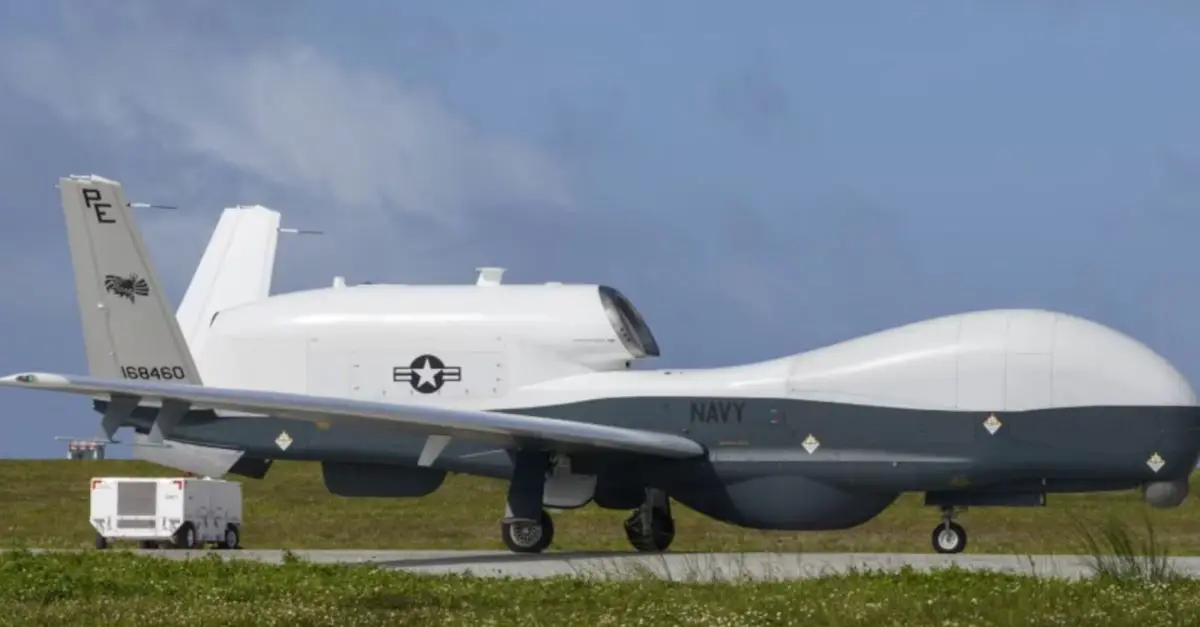Breaking news
US Navy deploys MQ-4C Maritime surveillance drone near China territorial water.
The U.S. Navy is preparing to deploy two Northrop Grumman MQ-4C Tritons to Kadena Air Base in Okinawa. This marks the first known deployment of this high-altitude, long-endurance (HALE) unmanned aerial vehicle (UAV) to Okinawa.

MQ-4C maritime surveillance drone ( HALE ) taking off at Anderson Air force Base, Guam, in 2020 (Picture source: US DoD)
The MQ-4C Triton, developed by Northrop Grumman for the U.S. Navy, is a high-endurance maritime surveillance drone designed to provide extensive ISR (Intelligence, Surveillance, Reconnaissance) coverage over vast and remote maritime areas. With a wingspan of 39.9 meters and a length of 14.5 meters, this drone can reach an altitude of 55,000 feet (16,764 meters) and fly for up to 30 hours uninterrupted at a cruising speed of 330 knots (611 km/h). The MQ-4C is equipped with sophisticated sensors, including a multi-function synthetic aperture radar (SAR) capable of detecting and tracking maritime and terrestrial targets, as well as advanced detection and alert systems. Its ability to cover vast oceanic areas in real-time, combined with high operational resilience, makes the Triton an essential asset for maritime surveillance and strategic intelligence gathering.
A U.S. Navy spokesperson confirmed on May 20 that the U.S. Pacific Fleet plans to temporarily deploy MQ-4C Tritons and associated personnel from Andersen Air Force Base in Guam to a location in Japan.
This MQ-4C drone, developed for maritime surveillance purposes, is being deployed to monitor activities in the waters southwest of the Japanese island. This use has been subtly hinted at by the Japanese Defense Forces' headquarters.
The U.S. Navy employs the MQ-4C as part of its Broad Area Maritime Surveillance (BAMS) program. The MQ-4C can be used for signals intelligence (SIGINT), communications relay, and search and rescue operations.
This information comes amid the highly tense situation between China and Taiwan. A large-scale military exercise took place on May 24, 2024, aimed at simulating a complete encirclement of the island and the bombing of strategic sites. While such exercises are relatively common, this one stands out due to the scale of the materials used and the scenario, but most notably because of the extremely martial rhetoric from Chinese officials, which is surprising in its vehemence. The United States, a long-time ally of Taiwan, has thus increased its presence on and around the island. Diplomatically, it would be complicated to bolster military forces directly on Taiwan or its dependent islands, as this would send a very negative diplomatic message to China. China is sensitive to this type of symbolic communication. However, in the region, the United States can rely on two other allies: the Philippines and Japan. Currently, the Philippines is the site of maneuvers by the U.S. Fifth Fleet, and Japan hosts several U.S. naval air bases.
This MQ-4C drone, developed for maritime surveillance purposes, is being deployed to monitor activities in the waters southwest of the Japanese island. This use has been subtly hinted at by the Japanese Defense Forces' headquarters.
The U.S. Navy employs the MQ-4C as part of its Broad Area Maritime Surveillance (BAMS) program. The MQ-4C can be used for signals intelligence (SIGINT), communications relay, and search and rescue operations.


























